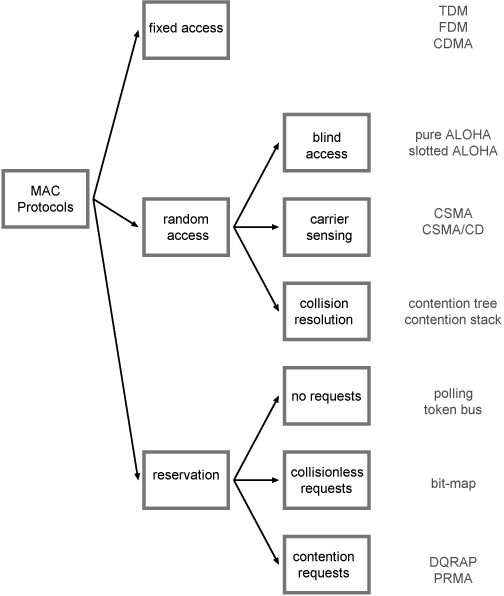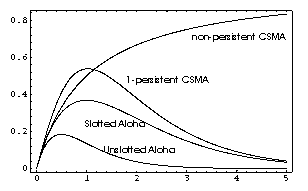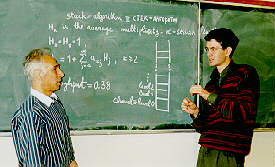
 | JPL's Wireless Communication Reference WebsiteChapter: Data Networks |
 Random access schemes dynamically assign radio resources to a
large set of users, each with relatively bursty traffic.
Random access schemes dynamically assign radio resources to a
large set of users, each with relatively bursty traffic.
A wide variety of solutions have been proposed to solve the problem of how to efficiently allow many terminals to transmit their randomly arriving messages.
 Audio playlist: Data transmission differs from circuit-switched
telephony. Particularly for bursty data or multimedia traffic, random access
schemes are needed. The ALOHA system was the first implementation of a wireless
packet data network. Such networks can exhibit instability problems. Boris Tsybakov
invented the "stack algorithm" to ensure stability. Similarly, Frits
Schoute's "Dynamic Frame Length ALOHA" also is stable. Jim Massey's
"Protocol Sequences" allow guaranteed throughput even if no feedback
is available.
Audio playlist: Data transmission differs from circuit-switched
telephony. Particularly for bursty data or multimedia traffic, random access
schemes are needed. The ALOHA system was the first implementation of a wireless
packet data network. Such networks can exhibit instability problems. Boris Tsybakov
invented the "stack algorithm" to ensure stability. Similarly, Frits
Schoute's "Dynamic Frame Length ALOHA" also is stable. Jim Massey's
"Protocol Sequences" allow guaranteed throughput even if no feedback
is available.
An series of slides giving an overview on random access:
html and ppt
ALOHA Radio Access
Any terminal is allowed to transmit without considering whether channel is idle or busy.
If packet is received correctly, the base station transmits an acknowledgement.
If no acknowledgement is received by the mobile, it retransmits the packet after waiting a random time.
Hidden terminals form a problem. Sometimes a new terminal may not be aware of an active transmission by another remote terminal.

| Figure: Throughput versus attempted traffic, for ALOHA, slotted ALOHA, 1-persistent and nonpersistent ISMA. Infinite population of terminals transmitting Poisson traffic of packets. |
Historical SettingProf. Boris Tsybakov discusses the history of the development of random access schemes, the difficulties in analyzing the performance of the stack algorithm, and the access issues in wireless. |

|
